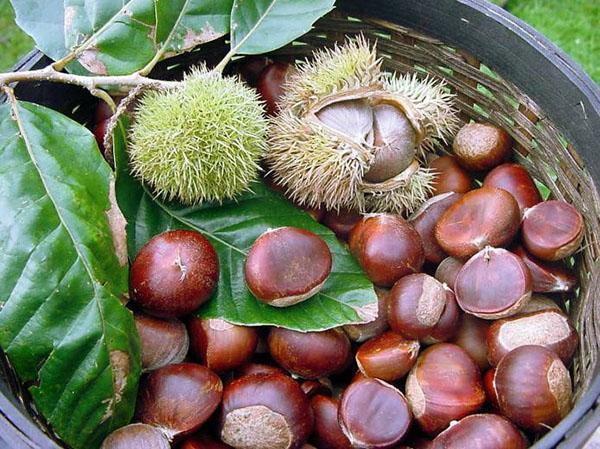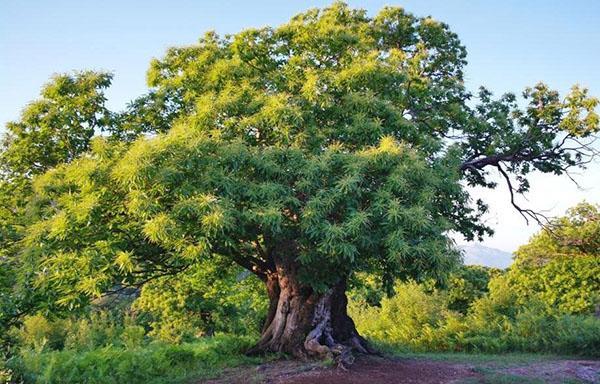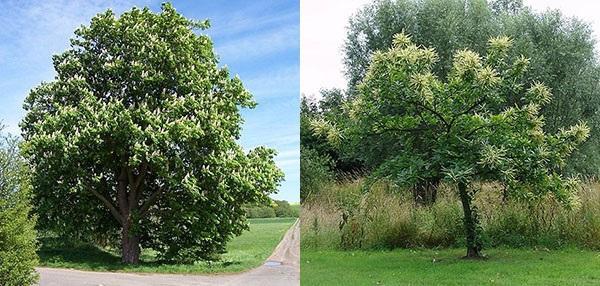Beauty and benefits in one bottle - edible chestnut
 Many believe that edible chestnuts are those trees that are found in parks and squares of large cities. In fact, this is not so, because you cannot eat their fruits. They are bitter and have practically no nutritional value, although they are used in medical practice. For landscape design, they most often use horse chestnut, which belongs to the Sapindova family. While its edible "relative" is a representative of the Beech family. Apart from the differences in the origin of these two species, they are not similar in appearance. Here are some secrets on how to tell the difference between edible (or sow) chestnuts and inedible ones.
Many believe that edible chestnuts are those trees that are found in parks and squares of large cities. In fact, this is not so, because you cannot eat their fruits. They are bitter and have practically no nutritional value, although they are used in medical practice. For landscape design, they most often use horse chestnut, which belongs to the Sapindova family. While its edible "relative" is a representative of the Beech family. Apart from the differences in the origin of these two species, they are not similar in appearance. Here are some secrets on how to tell the difference between edible (or sow) chestnuts and inedible ones.
The history of the name of this tree is rooted in Greek mythology. Jupiter was madly in love with one nymph. He persecuted her so much that she took her own life. The invented god turned the lost passion into a chestnut (Latin "caste" means - virgin, well, "Ney" is the name of the chosen one).
Find out: how to roast chestnuts.
"Two from the casket, but not the same from the face"

- Height. They can reach 35 to 50 meters in height, almost like a 14- or 20-storey building. But their "brothers" are not higher than 25 m.

- Fetus. Differs in increased "shaggy", because it is densely covered with thin elastic needles. Behind this "fur coat" is hidden from one to three flattened nuts, the mass of which is no more than 20 g. From one tree, you can collect up to 190 kg of harvest.

- Leaves. They do not look like the cone-shaped foliage of a horse-like kind gathered in luxurious fans. Each leaf of the edible chestnut is planted with short, not long, petioles. Its deciduous plate has an oblong-oval shape, 22 cm long and up to 7 cm wide.

- Inflorescences. These perennial plants bloom in the first half of summer - in June, and sometimes in July. Flowering is presented in the form of thin 15-centimeter ears, in contrast to the pyramidal brushes of its "relative".

Peeling nuts can be very difficult to remove. Therefore, some people practice soaking them in water for several hours.
You can collect the fruits of these representatives of the Beech family in the fall (October or November). While on the stomach, they ripen by September 1. It is worth remembering that an edible chestnut tree begins to bear fruit after 20 years after planting. This is five years later than other varieties. But in order to successfully grow these specimens in the country, you need to know their natural habitat.
Meeting place can not be Changed
 Representatives of the Sapindovy family need loose and fertile soil. Moderate climatic conditions have a beneficial effect on their growth and development. They are often found in the south of Europe and Russia, as well as in northern India, in eastern Asia, in China, Canada and the countries of North America. However, edible chestnuts grow mostly where the climate is more humid. Most often these are subtropical latitudes:
Representatives of the Sapindovy family need loose and fertile soil. Moderate climatic conditions have a beneficial effect on their growth and development. They are often found in the south of Europe and Russia, as well as in northern India, in eastern Asia, in China, Canada and the countries of North America. However, edible chestnuts grow mostly where the climate is more humid. Most often these are subtropical latitudes:
- Mediterranean (Italy, France, Spain);
- Asia Minor (Caucasus);
- Russian Federation;
- European part of Eurasia;
- U.S.A.
 Moreover, this species survives well in temperate climates. Therefore, it is grown to decorate some national parks and public recreation sites. In addition, edible chestnuts, the benefits of which were known many centuries ago, are widely used in cooking by many peoples.
Moreover, this species survives well in temperate climates. Therefore, it is grown to decorate some national parks and public recreation sites. In addition, edible chestnuts, the benefits of which were known many centuries ago, are widely used in cooking by many peoples.  The beneficial properties of the fruits, flowers, leaves and bark of this plant encourage gardeners to replenish their land with this variety.
The beneficial properties of the fruits, flowers, leaves and bark of this plant encourage gardeners to replenish their land with this variety.
For them, sudden changes in temperature are fatal. The scorching rays of the sun, as well as the stuffy air, dry out the leaves, leaving burns on them. Severe and prolonged frosts destroy the shoots / roots of the tree.
Two sides of the same coin
 It is important to know that there are both benefits and harms from an edible chestnut. Therefore, you should never abuse such a delicacy. These fried fruits are somewhat reminiscent of hazelnuts, as well as baked bread or charcoal potatoes... The composition of glossy nuts includes:
It is important to know that there are both benefits and harms from an edible chestnut. Therefore, you should never abuse such a delicacy. These fried fruits are somewhat reminiscent of hazelnuts, as well as baked bread or charcoal potatoes... The composition of glossy nuts includes:
- starch;
- varieties of fats (up to 6%);
- tannins;
- vitamins of groups B and A;
- carbohydrate bonds, more than 60%;
- trace elements.
This complex is a real explosive mixture for athletes. Once in the body, nutrients release an enormous amount of energy.
 The skin of the fruit contains the lion's share of fiber, so some dry the skin and then add it to food. From foliage, inflorescences and branches, tinctures, decoctions and infusions are made, which are used in the treatment of:
The skin of the fruit contains the lion's share of fiber, so some dry the skin and then add it to food. From foliage, inflorescences and branches, tinctures, decoctions and infusions are made, which are used in the treatment of:
- inflammatory processes;
- cough;
- bleeding;
- diseases of the digestive system (has astringent properties).
Among other things, nuts cause allergies. They are contraindicated in those with kidney problems. He is recommended to use them for those suffering from low blood pressure. Among the list of what edible chestnuts are useful for, it should be noted that their inflorescences are the rarest honey plants.  The honey obtained from them is highly valued among the inhabitants of the Caucasus.
The honey obtained from them is highly valued among the inhabitants of the Caucasus.
Dried nuts can be chopped in a blender. This powder is then added to any dough. Along with the exotic flavor, you can get a decent supply of fiber for your body.
Landing options
 Choosing a place for the future "giant" is an important task. Because of their unique, even "selfish", features, they rarely compete. The wide and dense crown blocks the light from the flowers growing below. In turn, the root system grows so much in the upper layers of the soil that it destroys all neighboring plants.
Choosing a place for the future "giant" is an important task. Because of their unique, even "selfish", features, they rarely compete. The wide and dense crown blocks the light from the flowers growing below. In turn, the root system grows so much in the upper layers of the soil that it destroys all neighboring plants.
Thus, in order to plant edible chestnuts in the country, you need to provide them with endless spaces. For each individual instance, it is necessary to select a place, the diameter of which should be 3-5 meters. This will allow the seedling to develop intensively. In addition, it is important to consider that these "giants":
- frost-resistant;
- perfectly tolerate air pollution;
- sun-loving;
- resistant to winds.
 Taking into account these points, the owners of personal plots will be able to enjoy the luxurious blooms and healthy fruits of the edible chestnut for a long time. As the tree grows, it will form a lush and spreading crown.
Taking into account these points, the owners of personal plots will be able to enjoy the luxurious blooms and healthy fruits of the edible chestnut for a long time. As the tree grows, it will form a lush and spreading crown.
Since nothing can be planted under such a "giant", this area can be used to install a bench or swing. In the heat of summer, they will become an indispensable resting place.
A few words should be said about the choice of soil. Experts advise that it be well-moistened chernozem (loam).  Although sandy soil is also a good option for planting, the tree will grow, develop and bear fruit slowly on it. But the calcareous soil almost immediately ruins the fragile sprout.
Although sandy soil is also a good option for planting, the tree will grow, develop and bear fruit slowly on it. But the calcareous soil almost immediately ruins the fragile sprout.
Working with seedlings
 The most optimal and fastest growing method for growing edible chestnuts is with the help of a young seedling. It is only important to make the necessary preparations:
The most optimal and fastest growing method for growing edible chestnuts is with the help of a young seedling. It is only important to make the necessary preparations:
- dig a square-shaped hole (each side - 0.5 m);
- lay a 15 cm pebble / crushed stone drainage layer on the bottom;
- mix earth, humus and sand (there should be 2 times more soil than the other components), as well as dolomite flour (500 g) in tandem with lime;
- add bait in the form of nitrogen, potash and phosphorus fertilizers.
 Now you need to carefully lay out the seedling from the container. Sprinkle the drainage with a part of the substrate, place a tree in the hole, and then add the remaining soil. Then pour plenty of summer water over the area. Make a mound near the root collar, which should rise 20 cm above the soil level. Still, for large varieties, the root collar should not be buried, but on the contrary, raise it to 10 cm higher than the planting tubercle.
Now you need to carefully lay out the seedling from the container. Sprinkle the drainage with a part of the substrate, place a tree in the hole, and then add the remaining soil. Then pour plenty of summer water over the area. Make a mound near the root collar, which should rise 20 cm above the soil level. Still, for large varieties, the root collar should not be buried, but on the contrary, raise it to 10 cm higher than the planting tubercle.
The young should be one or two years old. For him, you need to make supports, and attach the trunk to them.
Autumn work plan
 To do this, in November you need to collect as many nuts as possible. Only fallen, ripe specimens should be selected. Now the main thing is to do the cold hardening correctly. The gardener needs:
To do this, in November you need to collect as many nuts as possible. Only fallen, ripe specimens should be selected. Now the main thing is to do the cold hardening correctly. The gardener needs:
- put the fruits in a cellophane bag or box;
- cover them with sand;
- put in a refrigerator / basement (room temperature is not higher than +5 degrees);
- leave for 12 days, then transfer to open ground.
 On the site it is worth digging shallow furrows, somewhere 5-6 cm deep. Rinse with plenty of water. It is necessary to plant nuts-seeds every 15 cm, then cover them with a dense layer of fallen leaves, and leave them for the winter. In spring, it is worth removing weak shoots, leaving a distance of 50 cm between good seedlings.
On the site it is worth digging shallow furrows, somewhere 5-6 cm deep. Rinse with plenty of water. It is necessary to plant nuts-seeds every 15 cm, then cover them with a dense layer of fallen leaves, and leave them for the winter. In spring, it is worth removing weak shoots, leaving a distance of 50 cm between good seedlings.
After a year or two, some plants can be transplanted as a calibration. This should be done very delicately so as not to hurt the roots.
Spring chores with seeds
 It is noteworthy, but they begin in autumn, because the nuts covered with sand can continue to be stored in the basement until spring. They should be removed from this certification system and soaked in warm water prior to planting. It is important to monitor the condition of the fluid and change it as it gets dirty. This can be done daily. For five days of such "spa treatments" the peel swells and the embryo germinates.
It is noteworthy, but they begin in autumn, because the nuts covered with sand can continue to be stored in the basement until spring. They should be removed from this certification system and soaked in warm water prior to planting. It is important to monitor the condition of the fluid and change it as it gets dirty. This can be done daily. For five days of such "spa treatments" the peel swells and the embryo germinates.  After that, this nut is transferred to the ground, having previously prepared a site for the future tree so that the edible chestnut can grow intensively. Nevertheless, for the development of a strong root system, the top of the young sprouts must be pinched.
After that, this nut is transferred to the ground, having previously prepared a site for the future tree so that the edible chestnut can grow intensively. Nevertheless, for the development of a strong root system, the top of the young sprouts must be pinched.
Next spring, the growth of this seedling will already be 25 cm. And by the age of five it will reach 3 meters.
Caring in every move
 A young tree should be watered as the soil dries. Every month, the soil around the trunk must be loosened, of course, after watering. For the winter period you need to do mulch periosteal circle. Its height should be 12 cm. Such a “blanket” can be made from leaves, sawdust and peat.
A young tree should be watered as the soil dries. Every month, the soil around the trunk must be loosened, of course, after watering. For the winter period you need to do mulch periosteal circle. Its height should be 12 cm. Such a “blanket” can be made from leaves, sawdust and peat.
Every year (at the beginning of March), you need to feed the plant. In this case, you can use the following fertilization options:
- cow dung (1 kg per seedling of edible chestnut leaves);
- ammonium nitrate (for 15 liters of water 20 g);
- mineral fertilizers (containing nitrogen, potassium and phosphorus);
- urea.
 In this case, dry branches and missing leaves should be cut off. Such procedures are especially needed in the first years of life. In the future, experts advise to form the crown of this "giant" so that it has a luxurious look. As you can see, it is very easy to grow an edible chestnut on your land. A few competent tips and anxious care guarantee a stunning result.
In this case, dry branches and missing leaves should be cut off. Such procedures are especially needed in the first years of life. In the future, experts advise to form the crown of this "giant" so that it has a luxurious look. As you can see, it is very easy to grow an edible chestnut on your land. A few competent tips and anxious care guarantee a stunning result.